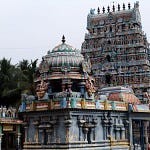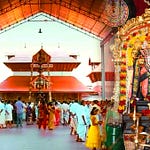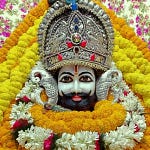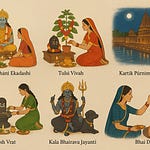“As Ravana’s effigies turn into ash and the night sky glows with firecrackers, a deeper silence whispers: Have you set fire to the Ravana within?
Dussehra, or Vijayadashami, is not merely a festival of external victory. It is the eternal reminder that the greatest battle is fought not on the battlefield of Lanka, but within the battlefield of the heart.”
Dussehra is rooted in the great epic Ramayana. After years of struggle, Lord Rama - guided by dharma and supported by Hanuman, Lakshmana, and an army of vanaras - defeated Ravana, the ten-headed king of Lanka.
Scriptures describe this triumph beautifully:
“Yato Dharmaḥ Tato Jayaḥ”
Where there is righteousness (dharma), there is victory.
(Mahabharata, 6.17.9)
This day is celebrated on the tenth day (Dashami) of the bright fortnight (Shukla Paksha) in the month of Ashwin (September–October). It also follows Navratri, where nine nights are dedicated to worshipping the Divine Mother, whose Shakti empowers all beings to rise above negativity.
Across India, Dussehra is celebrated in unique ways:
North India: Ravana’s effigies are burnt amidst Ram Lila plays.
South India: It commemorates Goddess Chamundeshwari slaying the demon Mahishasura.
Eastern India: Coincides with Durga Puja, where Goddess Durga conquers the buffalo demon.
No matter the form, the essence is the same: the destruction of adharma (unrighteousness) and the restoration of cosmic order.
The Symbolism of Ravana’s Ten Heads
Ravana was not an ordinary villain - he was a scholar of the Vedas, a master of music, and a powerful ruler. Yet his downfall came from his unchecked desires and arrogance. His ten heads symbolize the ten inner enemies:
Kama (Lust)
Krodha (Anger)
Lobha (Greed)
Moha (Delusion/Attachment)
Mada (Pride)
Matsarya (Jealousy/Envy)
Ahankara (Ego)
Dvesha (Hatred)
Bhaya (Fear)
Irshya (Resentment)
Each head represents a force that pulls us away from dharma. Burning Ravana’s effigy is thus a symbolic act of inner purification.
As the Bhagavad Gita reminds us:
“Uddhared ātmanātmānaṁ nātmānam avasādayet;
Ātmaiva hyātmano bandhur ātmaiva ripur ātmanaḥ.”
(Gita 6.5)“Elevate yourself through the power of your own mind. Do not degrade yourself, for the self can be both your friend and your enemy.”
Spiritual Essence of Vijayadashami
The word Vijaya means victory, and Dashami means the tenth day. Spiritually, it signifies the victory of higher consciousness over lower impulses. It is a reminder that:
The divine always prevails – Dharma may be tested, but it never perishes.
Every soul is Rama – radiant, pure, destined to conquer its inner demons.
Every challenge is Lanka – a field where we must act with courage and virtue.
The Ramayana itself is not just history (itihasa), but a mirror of the human journey:
Rama represents the higher self.
Sita represents the soul.
Ravana represents the ego that abducts the soul.
Hanuman represents devotion, the bridge to liberation.
Thus, Vijayadashami is not just a story - it is the soul’s eternal journey toward freedom.
Inspiring Stories & Lessons
1. Rama’s Victory
Rama defeated Ravana not with sheer power, but with patience, righteousness, and divine support. This teaches us that dharma, though tested, ultimately wins.
2. The Goddess and Mahishasura
In southern traditions, Vijayadashami also honors Goddess Chamundeshwari’s triumph over Mahishasura. Here, the feminine Shakti shows that inner courage, resilience, and grace are required to overcome chaos.
3. Durga Puja’s Culmination
In Bengal, this day is filled with both joy and tears - Durga returns to her divine abode after slaying the demon. This reminds us that every victory comes with surrender, and true devotion lies in letting go.
Shlokas & Spiritual Inspiration
On Overcoming Evil:
“Paritrāṇāya sādhūnāṁ vināśāya ca duṣkṛtām,
Dharma-saṁsthāpanārthāya sambhavāmi yuge yuge.”
(Bhagavad Gita 4.8)“To protect the righteous, to destroy the wicked, and to establish dharma, I manifest in every age.”
On Inner Strength:
“Ātma dīpo bhava” (Be a light unto yourself) – Lord Buddha.
On Burning Negativity:
“Just as fire burns wood into ashes, so does knowledge burn karma into ashes.”
(Bhagavad Gita 4.37)
Practical Reflections for Readers
Today, ask yourself: “Which Ravana lives inside me?”
Here are some spiritual practices to honor Dussehra deeply:
Self-Inquiry & Journaling – Write down one weakness you want to release. Symbolically burn that note, as Ravana’s effigy burns.
Meditation on Light – Visualize a flame in your heart, growing brighter, consuming anger, jealousy, or fear.
Chanting the Rama Mantra –
“Sri Rama Rama Rameti, Rame Rame Mano Rame;
Sahasra-nama tattulyam, Rama-nama varānane.”
(Chanting Rama’s name once is equal to chanting the thousand names of Vishnu.)Service (Seva) – Perform one act of kindness, replacing hatred with compassion.
Lighting a Diya – Place a lamp at home, signifying the victory of your higher self over darkness.
Rituals & Pujas Performed on Vijayadashami
1. Shami Puja
In Mahabharata, the Pandavas hid their weapons in a Shami tree during exile and retrieved them on Vijayadashami.
Even today, devotees worship the Shami tree and exchange its leaves (Shami patra) as blessings of prosperity.
2. Ayudha Puja (Worship of Tools)
Weapons, tools, vehicles, and even household instruments are cleaned, decorated, and worshipped.
Significance: recognizing divinity in all objects that serve us in life’s journey.
3. Vidyarambham (Initiation into Learning)
In Kerala and southern India, children are initiated into the world of letters on Vijayadashami by writing “Om Hari Shree Ganapataye Namah” in rice or sand.
Symbolizes wisdom as the ultimate victory.
4. Ravana Dahan (Effigy Burning)
Huge effigies of Ravana, Meghnath, and Kumbhkaran are set aflame at dusk.
Represents burning away arrogance, negativity, and evil.
5. Navami/Dashami Havan
Sacred fire rituals are performed in homes and temples to invoke blessings, burn karmic impurities, and invite prosperity.
Aartis & Mantras to Chant on Dussehra
🔱 Ram Aarti (Popular in North India)
“Shri Ramchandra Kripalu Bhajman,
Harana Bhava Bhaya Darunam…”
This aarti praises Rama as the remover of fear and destroyer of worldly sorrow.
Durga Aarti (Popular in Eastern & Northern India)
“Ambe Tu Hai Jagdambe Kali,
Jai Durge Khappar Wali…”
Chanting this aarti invokes divine motherly energy and protection.
✨ Hanuman Chalisa
Reciting Hanuman Chalisa on Vijayadashami is believed to give strength, devotion, and courage, just as Hanuman aided Rama in battle.
Dosha Nivaran Pujas (For Spiritual Cleansing)
Dussehra is also considered auspicious for performing dosha-removing rituals:
Kaal Sarp Dosha Puja – Removes obstacles, fears, and ancestral karmic blockages.
Pitru Dosha Puja – To honor ancestors and resolve unsettled ancestral karma.
Navagraha Shanti Puja – Worship of the nine planets to balance astrological influences.
Rahu-Ketu Shanti Puja – Particularly powerful on Vijayadashami for removing illusions and obstacles.
Many people visit sacred temples or perform these at home with the guidance of priests.
Temples to Visit on Dussehra
Raghunath Temple (Jammu) – Dedicated to Lord Rama, sees grand Dussehra celebrations.
Kullu Dussehra (Himachal Pradesh) – A UNESCO-recognized week-long festival where hundreds of deities gather in a grand procession.
Mysuru Chamundeshwari Temple (Karnataka) – Famous for Mysuru Dussehra, marked by grand processions of the Goddess.
Ramlila Grounds (Varanasi & Delhi) – Iconic effigy burnings with lakhs of devotees.
Kolkata Durga Puja Pandals – Culminates with Sindoor Khela and visarjan (immersion).
Kotappakonda Temple (Andhra Pradesh) – Celebrates Ravana Dahan uniquely with massive effigies.
Celebrating the Festival
The grandeur of Dussehra is seen in Ram Lila plays, massive processions, and the burning of effigies. But beyond the outer rituals lies a shared truth: society collectively affirms that evil will not prevail.
The flames rising toward the sky are not just about Ravana - they are about us, about burning corruption, injustice, hatred, and falsehood in the collective consciousness.
Dussehra is more than a festival- it is a spiritual mirror. It asks us:
Am I living in dharma?
Which Ravanas still bind me?
Have I ignited the inner light that no darkness can extinguish?
The real Vijayadashami happens not when Ravana’s effigy falls, but when we awaken to our own divinity.
As Tulsidas beautifully wrote in the Ramcharitmanas:
“Jo sumirat siddhi hoi, ganu nayaka karuna-nidhi soi.”
“He in whose remembrance all obstacles fall away - that merciful one is Rama.”
So, as you watch the flames dance in the night sky, let them remind you:
The Ravana outside may fall today, but the Ravana within must be burnt every day.











